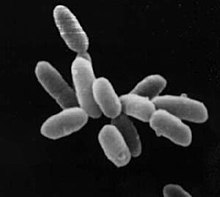Euryarchaeota
| Euryarchaeota | |
|---|---|

| |
| Halobacterium sp. strain NRC-1, each cell about 5 µm in length. | |
| Scientific classification | |
| Domain: | Archaea |
| Kingdom: | Euryarchaeota Woese, Kandler & Wheelis, 1990[1] |
| Phyla[2] | |
| |
| Synonyms | |
| |
Euryarchaeota (from
Description
The Euryarchaeota are diverse in appearance and metabolic properties. The phylum contains organisms of a variety of shapes, including both
Though it was previously thought that euryarchaeota only lived in extreme environments (in terms of temperature, salt content and/or pH), a paper by Korzhenkov et al published in January 2019 showed that euryarchaeota also live in moderate environments, such as low-temperature acidic environments. In some cases, euryarchaeota outnumbered the bacteria present.
Phylogeny
The currently accepted taxonomy is based on the List of Prokaryotic names with Standing in Nomenclature (LPSN)[9] and National Center for Biotechnology Information (NCBI)[10]
| 16S rRNA based | Dombrowski et al. 2019,[14] Jordan et al. 2017[15] and Cavalier-Smith2020.[16] | |||||||||||||||||||||||||||||||||||||||||||||||||||||||||||||||||||||||||||||||||||||||||||||||||||||||||||||||||||||||||||||||||||||||||||||||||||||||||
|---|---|---|---|---|---|---|---|---|---|---|---|---|---|---|---|---|---|---|---|---|---|---|---|---|---|---|---|---|---|---|---|---|---|---|---|---|---|---|---|---|---|---|---|---|---|---|---|---|---|---|---|---|---|---|---|---|---|---|---|---|---|---|---|---|---|---|---|---|---|---|---|---|---|---|---|---|---|---|---|---|---|---|---|---|---|---|---|---|---|---|---|---|---|---|---|---|---|---|---|---|---|---|---|---|---|---|---|---|---|---|---|---|---|---|---|---|---|---|---|---|---|---|---|---|---|---|---|---|---|---|---|---|---|---|---|---|---|---|---|---|---|---|---|---|---|---|---|---|---|---|---|---|---|---|
|
Other phylogenetic analyzes have suggested that the archaea of the clade polyphyletic group occupying different phylogenetic positions within Euryarchaeota. It is also debated whether the phylum Altiarchaeota should be classified in DPANN or Euryarchaeota.[14] A cladogram summarizing this proposal is graphed below.[15][16] The groups marked in quotes are lineages assigned to DPANN, but phylogenetically separated from the rest.
|
A third phylogeny, 53 marker proteins based GTDB 08-RS214.[17][18][19]
|
Euryarchaeota s.s. |
See also
References
- PMID 2112744.
- PMID 29522741.
- ^ Hogan CM (2010). E. Monosson, C. Cleveland (eds.). "Archaea". Encyclopedia of Earth. National Council for Science and the Environment. Retrieved 18 August 2017.
- PMID 24946804.
- ^ ISBN 9781118960608.
- S2CID 31381073.
- PMID 30691532.
- ^ S2CID 19425171.
- ^ Euzéby JP. "Euryarchaeota". List of Prokaryotic names with Standing in Nomenclature (LPSN). Archived from the original on 2017-08-09. Retrieved 2017-08-09.
- ^ Sayers; et al. "Euryarchaeota". Taxonomy Browser. National Center for Biotechnology Information (NCBI) taxonomy database. Retrieved 2017-08-09.
- ^ "The LTP". Retrieved 23 February 2021.
- ^ "LTP_all tree in newick format". Retrieved 23 February 2021.
- ^ "LTP_12_2021 Release Notes" (PDF). Retrieved 23 February 2021.
- ^ a b Nina Dombrowski, Jun-Hoe Lee, Tom A Williams, Pierre Offre, Anja Spang (2019). Genomic diversity, lifestyles and evolutionary origins of DPANN archaea. Nature.
- ^ a b Jordan T. Bird, Brett J. Baker, Alexander J. Probst, Mircea Podar, Karen G. Lloyd (2017). Culture Independent Genomic Comparisons Reveal Environmental Adaptations for Altiarchaeales. Frontiers.
- ^ PMID 31900730.
- ^ "GTDB release 08-RS214". Genome Taxonomy Database. Retrieved 6 December 2021.
- ^ "ar53_r214.sp_label". Genome Taxonomy Database. Retrieved 10 May 2023.
- ^ "Taxon History". Genome Taxonomy Database. Retrieved 6 December 2021.
- ^ Anja Spang, Eva F. Caceres, Thijs J. G. Ettema: Genomic exploration of the diversity, ecology, and evolution of the archaeal domain of life. In: Science Volume 357 Issue 6351, eaaf3883, 11 Aug 2017, doi:10.1126/science.aaf3883
- ^ Sometines misspelled as Theinoarchaea: Catherine Badel, Gaël Erauso, Annika L. Gomez, Ryan Catchpole, Mathieu Gonnet, Jacques Oberto, Patrick Forterre, Violette Da Cunha: The global distribution and evolutionary history of the pT26‐2 archaeal plasmid family. In: environmental microbiology. sfam 10 Sep 2019. doi:10.1111/1462-2920.14800
- ^ NCBI: Candidatus Poseidoniia (class)
Further reading
- Cavalier-Smith T (January 2002). "The neomuran origin of archaebacteria, the negibacterial root of the universal tree and bacterial megaclassification". International Journal of Systematic and Evolutionary Microbiology. 52 (Pt 1): 7–76. PMID 11837318.
- Woese CR, Gupta R, Hahn CM, Zillig W, Tu J (1984). "The phylogenetic relationships of three sulfur dependent archaebacteria". Systematic and Applied Microbiology. 5: 97–105. PMID 11541975.
- Garrity GM, Holt JG (2001). "Phylum AII. Euryarchaeota phy. nov.". In DR Boone, RW Castenholz (eds.). Bergey's Manual of Systematic Bacteriology Volume 1: The Archaea and the deeply branching and phototrophic Bacteria (2nd ed.). New York: ISBN 978-0-387-98771-2.
